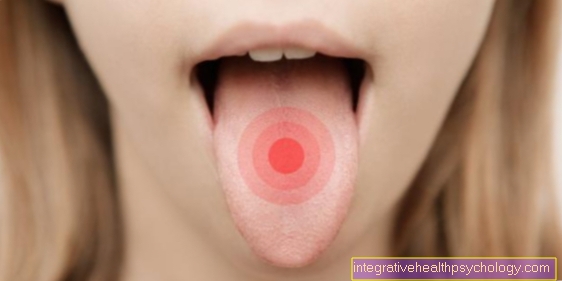Vesicles in the mouth
introduction
Blisters in the mouth are a common phenomenon that occurs in children and adults alike and can be a symptom of various diseases.
The oral mucosa is very sensitive. Inflammation and minor damage can be uncomfortable, which is especially noticeable when it comes into contact with acidic foods or liquids. Infections or injuries to the oral mucosa can therefore significantly disrupt food and fluid intake, even to a small extent.
But what are the annoying blisters in the mouth actually? The painful areas are mostly an expression of regionally damaged oral mucosa. Often it is an infection, but it is not always contagious.

Causes of the formation of blisters in the mouth
Canker sores
By far the most common cause of blisters in the mouth are so-called canker sores. These occur in children and adults and are harmless. These unpleasant changes in the mucous membrane can occur anywhere in the mouth.
An inspection usually reveals a point that is sharply circumscribed by a red border and a whitish, non-removable coating rests on it.A canker sore usually begins as a small, reddish blister that quickly grows into a small ulcer, known as a mucous membrane ulcer in medical terminology. The factors that trigger a canker sore are still largely unclear. Stress, hormonal factors, food intolerances and impairments of the immune system are discussed. Aphthae can appear individually or in groups on the oral mucosa.
One speaks of habitual canker sores when an individual has recurring canker sores. Apart from pain when eating or speaking, there are no other symptoms.
Herpangina
Another cause of vesicles in the mouth is the so-called herpangina. Here there are many vesicles with a strongly reddened edge, which are mainly grouped on the soft palate. There are also pronounced general symptoms with fever, fatigue, headache and swelling of the lymph nodes in the neck. Sometimes the entire oral cavity is red and painful. Although the name suggests infection with herpes viruses, the disease is caused by the Coxsackie virus.
An infection with the herpes virus is present in another disease, which owes its colloquial name "mouth rot" to the typical strong bad breath that occurs in those affected. The so-called stomatitis aphthosa is the initial infection with the herpes simplex virus type 1, which also causes cold sores. Since it is the first infection with a very common virus, the disease mostly affects young children. There are numerous vesicles that affect the entire oral mucosa and are surrounded by a reddened edge. This is accompanied by a fever and a pronounced feeling of illness. Since the intake of food and fluids is made significantly more difficult, small children in particular are at risk from lack of fluids.
Occasionally the varicella-zoster virus responsible for chickenpox can trigger unpleasant blisters on the face and on the oral mucosa. The viruses are able to survive in the body after the chickenpox disease and to spread along the nervous system. So they can cause repeated painful infections of the skin and mucous membranes.
Oral thrush
In addition to viral infections, fungal infections can also cause blisters in the mouth. So-called oral thrush is an infection of the oral mucosa with the yeast Candida albicans. This occurs on the skin of many healthy people and does not usually cause any symptoms. An infestation of the oral mucosa therefore mostly only occurs in small children or in immunocompromised people. There is a whitish, non-removable coating in the mouth that is typical of the disease. In addition, blisters and painful ulcers appear.
Read more on the topic: Inflammation of the lining of the mouth
Can that be herpes?
Burning and oozing blisters on the lip - this is the well-known picture of herpes infection. However, infection with herpes viruses can affect other parts of the body. These include, for example, genital herpes or an extremely painful inflammation of the eyes that requires immediate treatment. The first infection with the herpes virus can lead to a more severe course of the disease in an organism that has not yet dealt with the pathogen. Since the herpes simplex virus is very common, it mainly affects children.
Aphthous stomatitis is the very first infection with the herpes simplex virus that also causes cold sores. The entire oral mucosa is infected with painful blisters, which are characterized by a very reddened edge. This is typically accompanied by a strong bad breath and high fever as well as fatigue
Childhood diseases that cause blisters in the child's mouth
Mouth vesicles are a common problem in childhood and while canker sores occur in children and adults alike, aphthous herpangina and stomatitis are typical childhood diseases. Oral thrush is also more likely to occur in children than in healthy adults.
Another disease that predominantly affects children under the age of ten is hand, mouth and foot disease. Like herpangina, it is caused by the Coxsackie virus and begins with general symptoms such as fever and fatigue. After a few days, painful vesicles form in the oral mucosa. After a short time, the blisters turn into small ulcers, which are characterized by a greasy coating. As the disease progresses, a rash with blistering develops in the area of the mouth, hands and feet. Due to the not inconsiderable itching and pain, the children are very restless. Since, due to the formation of blisters in the mouth, food is often refused, the child's severe suffering usually continues on the parents.
All known antiviral drugs known today are ineffective. The symptoms can be alleviated through the use of pain relieving mouthwashes and gels. The disease has a good prognosis and usually heals within 7-10 days. There is a risk of infection for contact persons. The child must therefore stay away from community facilities such as kindergarten at least for the duration of the symptoms.
Children often react to pain caused by blisters in their mouth by refusing to eat or drink. This represents a great challenge for the parents, as the child's organism is particularly at risk of drying out. Drinking with a straw usually makes it easier for the little ones to absorb fluids.
Accompanying symptoms of vesicles in the mouth
With canker sores, there are usually no other symptoms. There is pain when eating and occasionally when speaking, but general symptoms are completely absent.
If symptoms such as severe exhaustion, fever, headache and aching limbs or lymph node swelling occur, a doctor should be consulted. There are clear indications that this is a disease that triggers a systemic reaction that affects the entire organism. There is often an accompanying strong salivation. Although the causative diseases are not diseases that often take a threatening course, medical treatment can help to quickly alleviate the symptoms. Especially with virus infections, the extensive infestation of the oral mucosa can make it much more difficult to eat and drink. While this leads to reduced performance and a strong feeling of illness in adults, the lack of fluids in children can have serious consequences.
Signs of severe lack of fluids in the child (desiccosis) are abnormal sleepiness, dry mucous membranes, highly concentrated urine and standing skin folds. Fever can quickly worsen the symptoms. A doctor should be consulted urgently.
The yeast disease thrush can also lead to desiccosis and weight loss due to insufficient food and fluid intake. Stubborn, non-peelable deposits appear on the oral mucosa. In the case of thrush, the infection can spread and lead to an inflammation of the esophagus or an infection of the gastrointestinal tract. Infection of the vaginal mucosa in women is also possible. The further infestation can lead to additional symptoms.
You might also be interested in this topic: Symptoms of a herpes infection
Blisters in the corner of the mouth - what can that be?
Blisters in the corner of the mouth can have various causes.
The typical painful blisters on the mucous membrane are in most cases the so-called canker sores. These usually heal on their own after 2-3 days without therapy. However, the canker sores only appear on the mucous membrane. If the sore is on the inside of the corner of the mouth, this can be a sore throat. However, if it is on the outside of the corner of the mouth or even on the lip, a sore throat is unlikely.
In the more common case, the sore will be herpes infection. In this so-called aphthous stomatitis, an initial infection with the herpes simplex virus, the vesicles can appear on the oral mucosa as well as on the lips. Often the vesicles also appear more frequently in the mouth or on the lips. In addition, fever, fatigue and bad breath can often occur.
In general, the herpes virus can very easily go undetected in the human organism. An outbreak or reactivation of the virus can e.g. come from stress, alcohol consumption, or immunosuppressive drugs. If an ointment or tincture is used, the cold sores usually disappear after about 1 week. In contrast to canker sores, cold sores are usually weeping and burning, while canker sores are particularly painful when touched.
Read more on the topic:
- Aphthae- what causes the painful blisters?
- Herpes in the mouth
Blisters in the mouth with lip involvement
In aphthous stomatitis, the blisters can also appear on the lips. The vesicles grow in the course of a few days, finally burst and an initially light, later yellowish encrusted secretion pours out.
In adults, the herpes disease usually progresses with the occasional formation of cold sores on the lips. The herpes virus survives in the human organism and very efficiently evades elimination by the immune system. The pathogens are usually reactivated in the event of stress, excessive alcohol or other infectious diseases.
Blisters in the mouth with a cold
A cold is usually a virus infection. Most often the so-called rhinoviruses are responsible for this, which especially in the cold winter months lead to an increase in the number of cases.
People who often suffer from canker sores sometimes notice an additional occurrence of annoying mucous membrane ulcers in addition to the symptoms of a cold. An accumulation of canker sores with flu-like infections and gastrointestinal diseases could be observed. It is not clear why, of all things, colds lead to increased mucosal damage.
The herpes virus can also be reactivated by a cold and lead to cold sores.
Read more on the topic: Symptoms of a cold
Diagnosis of vesicles in the mouth
The doctor will conduct a detailed anamnesis discussion, during which the patient has the opportunity to describe the nature and duration of his complaints. Accompanying symptoms should also be mentioned in order to make the diagnosis easier.
A subsequent physical exam usually focuses on the head and neck area and includes a flashlight and oral spatula inspection of the lining of the mouth. The localization of the mucosal damage and the occurrence of any other abnormalities are checked.
The condition of deposits can be checked with a tongue depressor. Most oral diseases are a visual diagnosis. This means that the findings of the physical examination in connection with the descriptions of the patient are sufficient to be able to make a diagnosis. A blood sample can provide information about whether the organism is currently affected by an infection or whether there is a general immune deficiency. Further laboratory tests are usually not necessary.
Therapy of vesicles in the mouth
Treatment depends on the disease. Most canker sores do not require treatment. The damaged oral mucosa heals by itself after a few days. Local anti-inflammatory measures can be taken if the pain is severe. This includes the application of clove oil or chamomile extract. Mouthwashes with numbing ingredients can also relieve pain.
Corresponding solutions are also used in herpangina. With this disease there is no way to fight the virus that caused it directly. Gargling with chamomile tincture can also contribute to the healing process. High fever should be reduced with paracetamol, a drug that also helps relieve pain.
In the case of aphthous stomatitis, anti-virus drugs are available against the herpes simplex virus. These should be used generously and in good time to shorten the duration of the illness. Mouthwashes can also help alleviate the symptoms.
Antivirals can also be used in severe cases of chickenpox virus infection. This is treated with the antiviral acyclovir.
A so-called antifungal agent is used for oral thrush. Antifungal drugs are drugs that are used to treat fungal infections. They are used locally as a mouth rinse for oral thrush. Pain relieving mouthwashes are also available here.
Read more on this topic at: Aphthae - which home remedies help against the pain?
Ointment against blisters in the mouth
A pain-relieving ointment can be applied to the damaged mucous membrane, especially with the occasional canker sores.
The preparations available without a prescription contain an anesthetic agent that quickly helps to temporarily improve the symptoms. However, this does not combat the triggering cause. Clove or chamomile tinctures can also be used. They have an anti-inflammatory effect and contribute to the rapid healing of the annoying mucous membrane ulcers.
Read more on this topic at: Aphthae - which home remedies help?
Are sores in the mouth contagious?
Ordinary canker sores are generally not contagious. This also applies to intensive contact, such as when kissing, for example.
Of the diseases described so far, herpangina (Coxsackie virus), stomatitis aphthosa (herpes virus) and hand, foot and mouth disease (Coxsackie virus) are contagious. Contact persons should apply strict hygiene measures. This includes frequent hand washing and disinfecting contact surfaces such as doorknobs or bathroom fittings.
Although oral thrush is a fungal infection, there is no risk of infection. The triggering yeast Candida albicans is also found on the skin of many healthy people and does not cause any symptoms if the immune system is intact.
Read detailed information on the subject: How contagious are canker sores?
How long do vesicles last in my mouth?
The duration depends on the illness. Ordinary canker sores usually heal completely after a few days, even without therapy.
Herpangina heals spontaneously after about 7-10 days. The same also applies to aphthous stomatitis if it is adequately treated.
In the case of oral thrush, the duration of the illness depends heavily on the immune system of the organism. With a good immune system and correct therapy, the disease heals after a few days. However, if the immune system is significantly reduced as part of another illness or chemotherapy, very long and stubborn processes can sometimes be observed.
Read more on the topic: Duration of canker sores

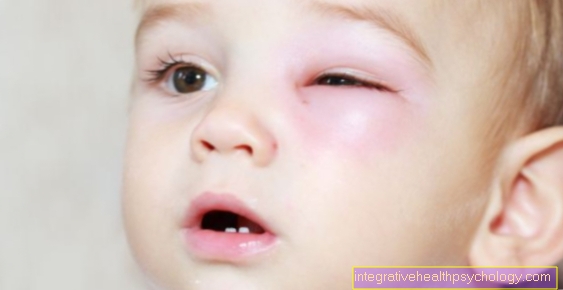
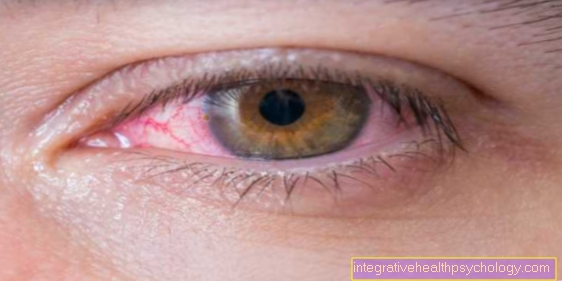


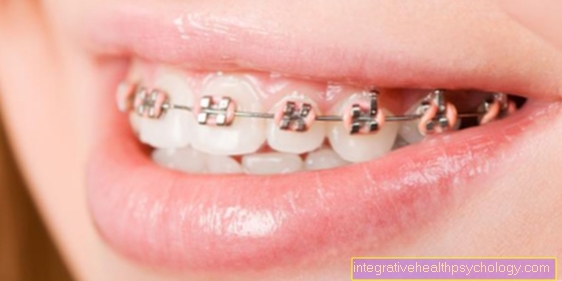

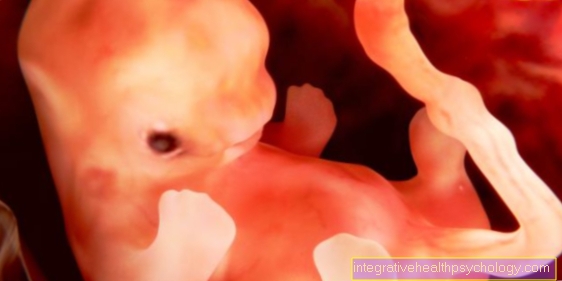







.jpg)



